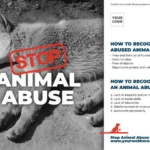The issue of animal cruelty in Texas has garnered considerable attention in recent years, reflecting a societal shift toward more humane treatment of animals. Understanding the legal framework surrounding animal cruelty is crucial for anyone interested in animal welfare. Is animal cruelty categorized as a felony in Texas? This inquiry delves not only into the law itself but also the broader implications of these legal statutes on animal welfare and societal values.
Animal cruelty encompasses a range of actions that cause suffering or harm to animals. In Texas, the legal definition of this offense is grounded in the Texas Penal Code, specifically under Title 9, Chapter 42. The law significantly differentiates between various forms and severities of animal cruelty, thereby illuminating the nuanced perspectives that lawmakers and society have taken toward animals.
At its core, the law outlines two principal types of offenses: “Cruelty to Livestock Animals” and “Cruelty to Non-Livestock Animals.” Each category possesses its distinct stipulations and penalties. Livestock, which includes animals such as cattle, horses, and sheep, is afforded some protections under the law, yet the treatment of non-livestock animals garners a more rigorous standard of care.
For instance, cruelty to non-livestock animals is a Class A misdemeanor, but if the offense involves serious bodily injury or death to an animal, it escalates to a state jail felony. This distinction is critical; it underscores society’s evolving view of animal rights and reflects a growing recognition of animals as sentient beings deserving of protection. The stark differences in penalties for various forms of cruelty illustrate the legislative intent to deter egregious acts while still allowing for some flexibility in enforcement.
Another essential aspect of the law is the degree of intent required to prosecute an individual for animal cruelty. In Texas, an individual must be found to have intentionally, knowingly, or recklessly caused harm to an animal. This requirement emphasizes the importance of culpability in assessing whether an act constitutes cruelty. Accidental harm, while tragic, does not typically fall under the strict definitions established by law.
Despite these legal protections, one must ponder the efficacy of such laws in practice. Enforcement can often be inconsistent. Agencies responsible for overseeing animal welfare, such as local law enforcement and animal control, may face limitations in resources, training, and public awareness. Consequently, many cases of animal cruelty go unreported or unpunished, signaling a pervasive gap between legislative intent and practical application.
In recent years, there has been a palpable shift towards stronger enforcement of animal cruelty laws in Texas. Initiatives like community outreach programs and public awareness campaigns aim to educate citizens about animal rights and the legal ramifications of cruelty. This transformation reflects a societal shift—where once the cruelty of animals was often overlooked or normalized, there is now a growing acknowledgment that our treatment of animals is a reflection of our humanity.
Moreover, the rise of advocacy groups dedicated to animal welfare has played an instrumental role in amplifying voices that demand change. Organizations and activists persistently work to raise awareness, pushing for stronger legislation and encouraging community engagement in issues pertaining to animal rights. Their efforts signify a collective desire for tangible measures that prevent cruelty and promote compassionate treatment of all sentient beings.
One must also consider the implications of a growing body of public sentiment surrounding animal cruelty. The increasing inclination toward pet ownership and the anthropomorphism of animals in contemporary society have paved the way for a re-evaluation of their status within the legal framework. As communities rally against instances of abuse or neglect, the message is clear: cruelty will not be tolerated.
Interestingly, the ramifications of animal cruelty laws extend beyond the realm of animal rights. Studies indicate a troubling correlation between animal cruelty and violent behavior toward humans. Such findings advocate for a holistic approach where addressing animal welfare can, in fact, enhance public safety. The legislative momentum we see today is not merely about animals—it’s also about cultivating a society that intrinsically values empathy, respect, and compassion.
As we explore the evolving landscape of animal rights, one pivotal question remains: what does it mean to achieve true justice for these voiceless creatures? The answer lies within our collective capacity to not only comprehend the law but actively participate in its evolution. Engaging with local officials, supporting humane societies, and advocating for comprehensive animal welfare laws are all integral steps toward this objective.
Ultimately, while animal cruelty is indeed a felony in Texas under specific circumstances, the broader challenge lies in the persistent effort to uphold and enforce these laws. A culture that prioritizes the well-being of animals reflects not just legal progress, but a moral victory in our journey towards a more compassionate society. With continued vigilance and advocacy, Texas can signify a pioneering shift toward a future where animal cruelty is utterly eradicated, and empathy prevails as the guiding principle of our interactions with the animal world.










